10º edición: 2 al 7de abril de 2019 | English


![]() CAMPUS GENIUS
CAMPUS GENIUS
![]() CONTEST. JAPAN
CONTEST. JAPAN
![]()
![]() ARS ELECTRONICA
ARS ELECTRONICA
![]()
![]() ART FUTURA
ART FUTURA
![]()
![]() KIMUAK
KIMUAK
![]()
![]() MIDEN
MIDEN
![]()
![]() NOW & AFTER. Moscú
NOW & AFTER. Moscú
![]()
![]() MADE IN CANARIAS
MADE IN CANARIAS
![]()
![]() DIGITAL LANDSCAPE
DIGITAL LANDSCAPE
![]() & Programa Curators
& Programa Curators
![]() - ARGENTINA
- ARGENTINA![]()
![]() - PERÚ
- PERÚ
![]()
![]() IMAGEN DIGITAL
IMAGEN DIGITAL
![]() Videoarte
Videoarte
![]() Videodanza
Videodanza
![]() Cortometraje / Film
Cortometraje / Film
![]() Web Film / 3D
Web Film / 3D
![]() Animación
Animación
![]()
![]() Arte Ciencia Innovación
Arte Ciencia Innovación
![]() Artificial life
Artificial life
![]() Software art
Software art
![]() Trangenic art
Trangenic art
![]() Generative art
Generative art
![]() Bioart
Bioart
![]() Nanotecnología
Nanotecnología
![]() Geospatial storytelling
Geospatial storytelling
![]() Videojuegos
Videojuegos
![]() Robótica
Robótica
![]() Free Software
Free Software
![]() 2D & 3D Animación
2D & 3D Animación
![]() Net-art
Net-art
![]() Comunidades Digitales
Comunidades Digitales
![]() Redes Sociales
Redes Sociales
![]() Blog, videoblog
Blog, videoblog
![]() Desarrollo Apps
Desarrollo Apps
![]() Plataformas móviles
Plataformas móviles
![]() Visualización datos
Visualización datos
![]() Mapping
Mapping
![]() Acciones telepresencia
Acciones telepresencia
![]()
![]() somos
somos
![]()
![]() patrocinadores y
patrocinadores y
![]() colaboradores
colaboradores
![]()
![]() fotos de la sede
fotos de la sede ![]()
![]() lugar
lugar
![]()
![]()
![]() evento 2009
evento 2009
![]()
![]() evento 2010
evento 2010
![]()
![]() evento 2011
evento 2011
![]()
![]() evento 2012
evento 2012
![]()
![]() evento 2013
evento 2013
![]()
![]() evento 2014
evento 2014
![]()
![]() evento 2015
evento 2015
![]()
![]() evento 2016
evento 2016
![]()
![]() evento 2017
evento 2017
![]()

-SOFTWARE ART
-TRANSGENIC ART
-GENERATIVE ARTS
-BIOART
-NANOTECNOLOGÍA
-GEOSPATIAL STORYTELLING
-VIDEOJUEGOS
-ROBÓTICA
-OPEN SOFTWARE
-2 & 3D ANIMACIÓN
-NET ART
-COMUNIDADES DIGITALES
-REDES SOCIALES
-BLOG, VIDEOBLOG
-DESARROLLO APPS
-PLATAFORMAS MÓVILES
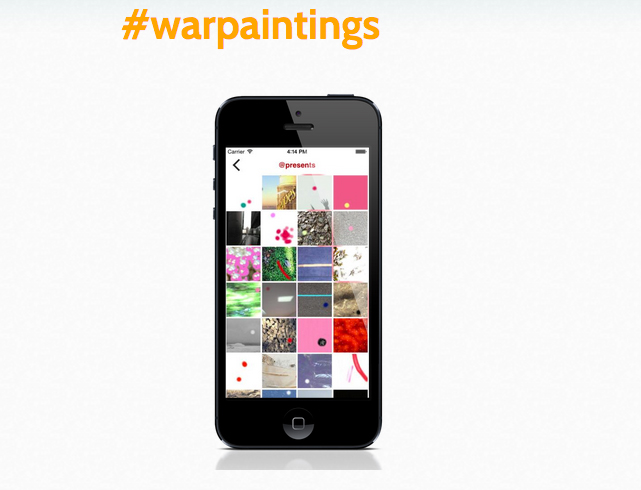
Elia Barez
Lisboa, Portugal
http://www.adianteapps.com/phgxsy
Proyecto: #warpaintings app
Esta aplicación ha sido creada a modo de libro de artista. Un libro de artista con un formato nuevo, contemporáneo. Con ella, se pretende resaltar la necesidad de una evolución en la exposición del arte, en su disfrute y en el modo que tenemos de compartirlo. Las #WARPAINTINGS o pinturas de guerra digitales, fueron creadas para ser expuestas y distribuidas de forma digital. Primero en forma de una instalación, en la que a través de una conocida aplicación de mensajería instantánea se distribuían a todo aquel espectador que lo requiriese contactando con la artista para solicitarlo y ahora a través de esta aplicación. En la era digital, parece necesario que el arte se vuelva también, realmente digital, y que su distribución sea a través de este medio, o se vea modificada por él. Vivimos en un mundo cada vez más líquido, que implica una fluidez que deberá verse reflejada en las distintas manifestaciones artísticas. Todas la imágenes dispuestas en esta aplicación están sometidas a una Licencia Creative Commons según la cual: - puedes compartirlas e incluso modificarlas. SIEMPRE que: - menciones su autoría inicial y los cambios realizados en ellas. - las compartas bajo el mismo tipo de Licencia. En este libro de artista digital se presentan cuatro series de #WARPAINTINGS: - @presents - Mauritania - Reykjavík, mon amour - Casa
tag: app
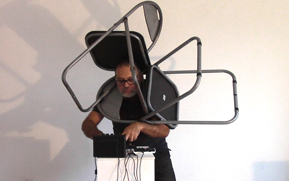
Osvaldo Cibils
https://www.instagram.com/osvaldocibilsosvaldocibils/?hl=es
Proyecto: Osvaldo Cibils en el arte de las perillas (the art of knobs)
Osvaldo Cibils en el arte de las perillas (the art of knobs) soundart ruidoso con artilugios electrónicos y el cuerpo exagerado con cosas. Serie en curso de videoperformances en Instagram red social y aplicación.
tag: mobile phone
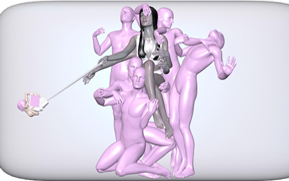
Sandrine Deumier
Francia
http://sandrinedeumier.com
Proyecto: Pink party
Pink party is a mechanical ballet set in the era of cyborgs and artificial human behaviors. Comprised of several scenes, Pink Party combines indistinctly cybernetic chimeras, humanoids and objectified humans with reversible identities and behaviors. Each scene depicts a disturbingly prefigurations of artificial humannity.
tag: 2D & 3D animation

George Snow
Cortona, Italia
www.george-snow.com
Project: Alberti Piranesi Escher
APES stands for Alberti, Piranesi, Escher and Snow. It was the work of the time honoured architects that inspired this production which was originally funded by the Arts Council of Great Britain. It evolved subsequently into a panoramic movie, a Unity game and is now an Oculus Rift VR experience. In this world of stone, steel and steam I have placed elements of my 80's collage work, steam locomotives from the Museum of the Countryside in Città di Castello, Leonardo's flying machine and a goods wagon which hauled victims to the concentration camps of Nazi Germany. Space as defined by architecture has been a recurring theme in my graphic work since the 80's and is echoed in my dramatic work such as 'The Man of the Crowd' (set in the streets of London) and 'The Assignation' (set in Venice). Technical dates Viewed as 360 degree panoramic projection or in Oculus Rift headset. Here is the Oculus Rift version as a movie. https://www.youtube.com/watch?v=kLbdxdobMZk It is also possible to view in Oculus Rift as an immersive interactive experience. Here is a preview. https://vimeo.com/173947419
tag: software art
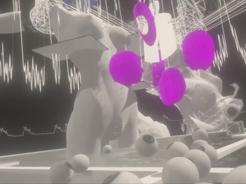
Pascal Silondi and Klara Silondi
Praga, República Checa
http://www.libat.net/
Proyecto: VERTIGO
S VERTIGO (Virtual Reality installation) The revolt of the guinea pig Vertigo is an interactive art installation that invites users to discover a surrealist and futuristic journey in virtual reality. It is an immersive 3D environment that uses the principles and techniques of video games to offer an atypical physical and aesthetic experience to the public. The spect-actor equipped with a virtual reality headset, the HTC Vive, and its hand controllers, will be able to move in the virtual space by defying the laws of gravity, and will be able to interact with different objects that populate this surreal and High Tech "cadavre exquis" to reveal hidden properties. Sometimes close to a climbing simulator, Vertigo allows you to discover disproportionate and improbable digital landscapes composed of shifted elements, such as parts of anatomy or architecture, everyday objects revisited, CCTV cameras, magnetic forces or samples of media extracted from the society of the spectacle 3.0. It is a playful experimental space at the heart of contemporary artistic representation that aims to produce a feeling of vertigo of the senses but also to initiate a reflection about the nature of our information society and its excesses. It's an intimate and sensitive relationship between universes in expansion. The structure and behaviors of the Virtual 3D environment as well as the artificial life principles and characters are closely listening to sound frequencies and aim to reflect through their reactions the complexity and the deepness of human inner pulsations, an uncanny dialogue between waves and structures ,an emotional voyage between cosmic beings who are floating in time-space unsolved distortions and dissonances. https://vimeo.com/289248030
tag: software art
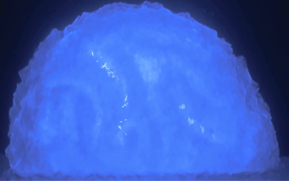
Citron | Lunardi
Chioggia, Venice (Italia)
URL 3294122478
Proyecto: Back up my memories
Back up my memories is a reflection on the disquieting perspectives offered by cryopreservation. Is it possible to crystallize the brain? Can memories be frozen before death to be defrosted in the near future thanks to new scientific discoveries? Back up my memories is about the fear of losing memory and therefore of dying. Recovering memories means to long for immortality. This disquieting outlook could become reality in the coming era of Singularity, which is a future based on the complete fusion between man and machines. So, the fear of losing memories will become the fear of losing data. At the same time, the video imagines a future in which the infinite digitization and quantification of data has made information overloaded starting a process of crystallization. And certainly the more we will be connected to machines that will keep us alive, the more we will be imprisoned inside a global crystalline structure of data, information and technology from which we will no longer be able to separate ourselves as it could mean accepting death. Year of production: 2018
tag: software art
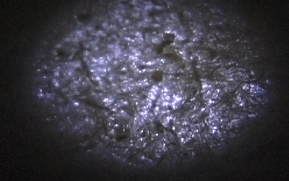
Jockel Liess
Londres, UK
www.jockelliess.org
Proyecto: Irregular atmospheric motion
Irregular atmospheric motion is a meditative audiovisual environment with no clear beginning end, or progression. It rather exists as layers of organic interwoven textures, emerging frequencies and their continuous subtle disturbance. The fluidly intertwining alterations in image and sound thus amalgamate to create a mesmerising display of impermanence. A display modelled on the intrinsic behaviour of natural organic systems, characterised by the attractiveness of eternal turbulence and flux. Within the work stability only exists in its perpetual absence. Technical dates Production date: 2018 Duration: 10:16 Aspect ratio: 4:3 Format: QuickTime movie The submitted work is a 10-minute audiovisual recording of the non-durational live generative computer improvisation 'irregular atmospheric motion' performed in Max/MSP and Jitter. Image and Music by Jockel Liess
tag: generative arts
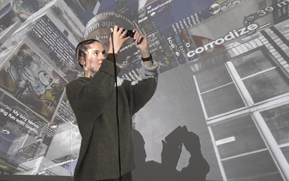
Marc Lee
Suiza
http://marclee.io/en/echolocation/
Proyecto: Echolocation – Mapping the Free Flow
of Information Around the World in Realtime
In Echolocation users can choose any location on a map and move through stories posted from there by others on social networks like YouTube, Flickr and Twitter. Here these personal impressions are streamed in real time like windows to our changing world. The viewer participates in the social movements of our time and makes a journey into constantly new image and sound collages in which one experiences local, cultural and linguistic differences and more and more similarities. We live in a globalised world that is becoming increasingly homogeneous. Languages, plant and animal species are continuously decreasing. Supermarkets, buildings and cities look more and more alike. The work deals with cultural diversity on the African continent and at the same time with the powerful homogenising forces that are being exerted on this diversity also in the social-digital realm, and poses questions about the meaning of this ever-increasing flattening of forms and images. Technical dates
tag: generative arts
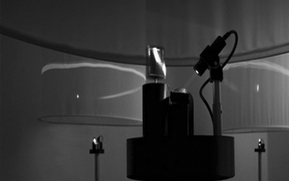
Riccardo Torresi, Maxime
Lethelier, Asako Fujimoto
Berlín, Germany
https://ephemeraltomorrow.com/
Proyecto: GW 170817 SPECULUM
In 1915, when publishing his General Theory of Relativity, Einstein changed the world conception and opened the door to an infinity of new possibilities by arguing that gravity is the product of mass bending space and time. Therefore, when powerful masses in space are set in motion, this causes waves in space-time, which rush through the cosmos at the speed of light and deform all objects on their way, according to their distances. For forty years, astrophysicists tried unsuccessfully to prove the existence of gravitational waves, which until then had only been assumed theoretically. But even if this theory stayed purely hypothetical, it was used as the theoretical basis for astrophysical research. This situation is very common in physics - theories are put forward that yet have to be proved or refuted. In this process, theoretical assumption and valid proof, genuineness and speculation are constantly competing. Most of the times this concerns cosmic events, which are only perceptible to humans through the use of advanced technical instruments. Only three years ago the existence of gravitational waves was finally proven, with the help of super-detectors at the Laser Interferometer Gravitational-Wave Observatory (LIGO) in Louisiana and Washington.LIGO was able to measure the otherwise barely noticeable changes caused by these astronomical events. In 2017 the scientists Rainer Weiss, Kip Thorne and Barry Barish were rewarded with the Nobel Prize in Physics for their role in detecting gravitational waves. Speculum, the Latin word for mirror, is the root of the verb speculate, which used to mean looking at the stars, and also speculation, the forming of a theory or conjecture without firm evidence. GW170817 SPECULUM seeks to investigate, as well as speculate, around a particular event: the recording of gravitational waves produced by the merging of two neutron stars on August 17th 2017 by the LIGO Hanford, LIGO Livingston and Virgo detectors (also known as GW170817). In the installation, laser beams are reflected by rotating mirrors on to a cylindrical fabric, creating waves according to the event's data recorded in each one of the 3 detectors. Gravitational waves moving through time and space, which were transformed into measurable data sets, are translated back into sound and light in motion, through the same means used to detect them. The generated visuals behave differently than the original gravitational waves, yet they are able to show this cosmic phenomenon in a more perceivable way.
tag: generative arts
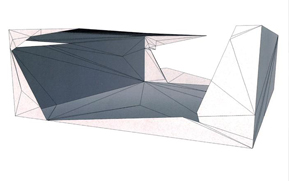
Eugenia Fratzeskou
Londres, UK
Proyecto: Boundary Transmutations
What appears as a 3D space simulation operates as a trans-material system in an invisible but dynamic algorithmic environment for registering phase-boundary formation, transitions and defects, Möbius-like paradoxes, hysteresis, crisis points, etc., challenging preconceptions about matter. The series are part of my current research into the adaptation of the scientific concept of phase-space for advancing spatial praxis across various disciplines in the light of new critical theory discourse, nuclear physics, quantum mechanics, materials technology and computational chemistry.
tag: generative arts
